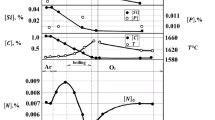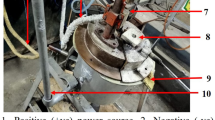Conclusions
It is shown that it is possible in principle to carry out the sorption deoxygenation of a metal by refractories. A highly developed surface helps to provide a more complete sorption deoxygenation.
Experimentally, periclase has better sorption properties than corundum.
Most of the oxygen is removed from the melt in the first 5–10 min. The extent of the oxygen removal from the melt increases with an increase in its original concentration.
Similar content being viewed by others
Literature cited
B. F. Belov, I. A. Novokhatskii, O. P. Vol'pert, et al., Izv. Akad. Nauk SSSR, Met., No. 1, 67–70 (1975).
M. Sh. Barenboim, O. A. Val'dman, O. N. Terent'ev, et al., Ogneupory, No. 9, 40–42 (1980).
G. N. Okorokov, A. G. Shalimov, V. M. Antipov, and N. A. Tulin, Production of Steel and Alloys in Vacuum Induction Furnaces [in Russian], Metallurgiya, Moscow (1972).
Yu. V. Sveshkov, V. A. Litvak, V. A. Kalmykov, et al., Zavod. Lab.,40, No. 5, 557–558 (1974).
Author information
Authors and Affiliations
Additional information
Translated from Ogneupory, No. 3, pp. 22–24, March, 1984.
Rights and permissions
About this article
Cite this article
Turdzhuman, G.S., Karasev, V.P., Val'dman, O.A. et al. Sorption removal of oxygen by refractory materials from iron-nickel melts. Refractories 25, 148–151 (1984). https://doi.org/10.1007/BF01398350
Issue Date:
DOI: https://doi.org/10.1007/BF01398350




